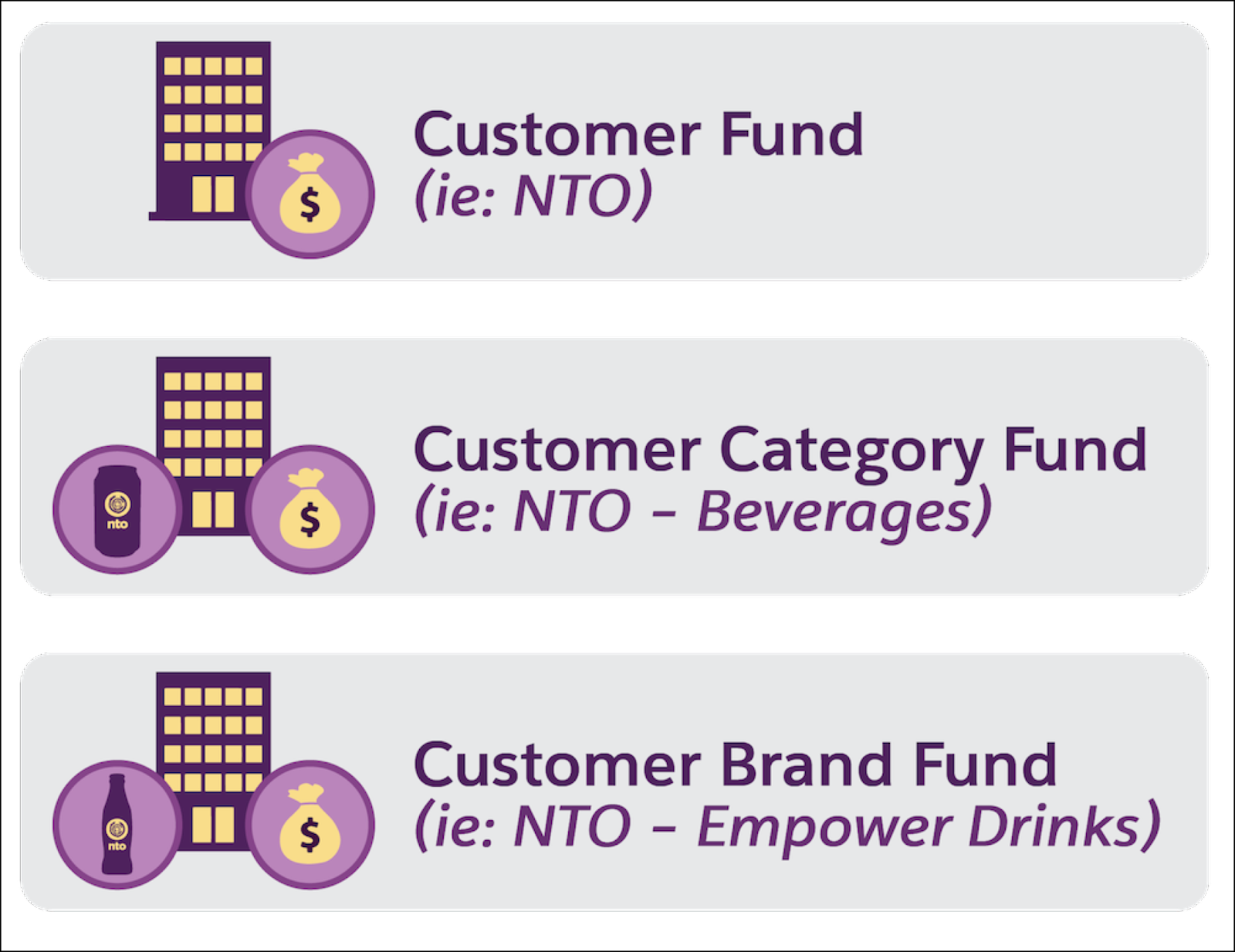Get Started with Fund Management
Learning Objectives
After completing this unit, you’ll be able to:
- Explain the basics of fund management.
- Describe fixed funding and rate-based funding.
- Identify different types of funds.
Before You Start
Before you start this module, consider completing the following recommended content.
Fund Management Basics
Fund management is a core process in Salesforce Trade Promotion Management with Consumer Goods (CG) Cloud. A fund holds money that forms the promotion budget for a product or brand. Managing funds involves setting them up and transferring money to and from those funds. Funds are linked to specific promotion tactics, giving manufacturers spending control over those tactics.
Every manufacturer determines a budget for annual trade promotional activities. They capture the budget within a fund and use the budget to plan trade promotions. Manufacturers like Alpine Group spend considerable sums to run promotions and tactics at retail stores.
Hello, Fund Ninjas
Meet Carol Lee, the finance manager at Alpine Group Nutrition & Beverage.

Carol’s job responsibilities include fund management, budget allocation, invoice management, and deduction resolution. Let’s learn more about her role.
Managing company finances can be a tremendous challenge, but Carol has a knack for it. She’s in charge of financing the budget for Alpine Group product promotions at various retail stores. Specifically, she handles funds for the retail account Northern Trail Outfitters (NTO), a nationwide chain in the USA. Though her job is stressful, Carol always greets people with an authentic smile and warm words. Everybody loves Carol and her pink hair!
Alas, her work is never done, and she’s constantly juggling tasks, including:
- Managing funds and budget allocation
- Handling invoices and resolving deductions
- Understanding account plans and corporate-sponsored promotion strategies
- Using financial dashboards for analysis
- Reviewing and approving claims raised by retailers
- Monitoring financial key performance indicators (KPIs) within and across accounts
- Aligning with annual stakeholders, such as sales and marketing teams, on annual budgets
- Reporting to management
Impressive, right? Despite her can-do attitude, Carol’s often exhausted at the end of the day, with work piling up around her. She dreams of a better way of getting her job done.
For now, let’s turn our attention to Gustavo De Luca, a seasoned key account manager at Alpine Group who works closely with Carol. Carol helps Gustavo to manage and optimize the trade promotion budget and meet financial goals.

Bright and hardworking, Gustavo manages the sales and promotions for Alpine Group products at NTO retail stores. He oversees the day-to-day retail activities of his team of field sales reps, with an eye for keeping sales and promotional compliance high. In addition, Gustavo plans and negotiates trade promotions with retailers, spends allocated funds, and works with finance managers to revise budgets as needed.
Gustavo monitors NTO’s target sales volume for various brands and products. Lately, sales have slumped, leaving Gustavo scratching his head. He realizes it’s time for action. And what better action than a compelling promotion?
But, like many good things, promotions don’t come for free. So Gustavo reaches out to Carol to secure a workable budget. While they need to work hard to secure the relevant budget, they also need to be careful not to overdraw funds.
Let’s follow Gustavo as he explores fund types and their uses, creates fund templates, and more.
Fixed Funding and Rate-Based Funding
Gustavo is keen to learn all about the fund types available in CG Cloud. He discovers two basic ways to build budgets for promotional activities.
Funding Method |
Description |
|---|---|
Fixed funding |
With fixed funding, a key account manager receives a set amount as a budget. |
Rate-based funding |
With rate-based funding, a key account manager receives a flexible amount based on the planned volume or revenue of the customer. |
After deciding the funding approach, Gustavo creates the funds in Salesforce Trade Promotion Management and applies them to promotional activities. This includes paying for additional shelf space for promoted products and discounting product prices at NTO stores during the promotion timeframe.
Fund Types
But, the intricacies of fund management don’t stop there. Gustavo discovers that the usage of a fund determines its type. He explores three typical ways to create and manage funds based on how they’re used.

Finance managers like Carol use these fund types to allocate budgets for customers, product categories, and brands.
-
Customer funds: These are typically account or market development funds used by key account managers for their customer accounts. Customer funds are always associated with customers as opposed to products. For example, Carol creates a customer fund for NTO.
-
Customer category funds: This fund type applies to certain product categories, such as beverages or snacks. Carol creates another fund for NTO beverages.
-
Customer brand funds: These are typically brand-development funds for activities related to a specific customer and brand. For instance, Carol creates a fund for the NTO beverage brand, Empower Drinks.
A Salesforce admin can create other fund types within these usage-based types. For example, an admin can set up customer fund types, such as an account development fund or a market development fund. In turn, finance managers like Carol use the fund types to create funds for different customer-product combinations in line with promotional budgets.
Forward, March!
In this unit, Gustavo explored the basics of fund management, including the types of funds available in Consumer Goods Cloud. In the next unit, he learns about KPIs and transaction types. Go, Gustavo!
Resources